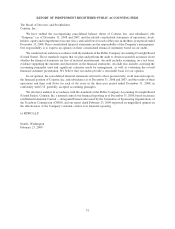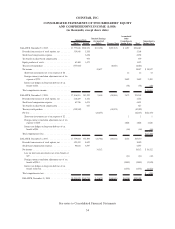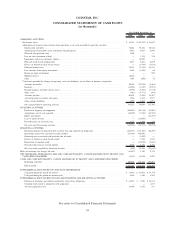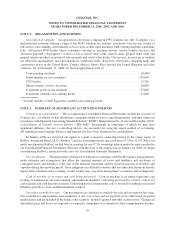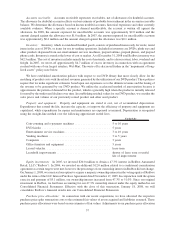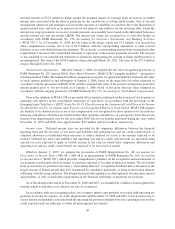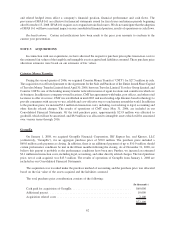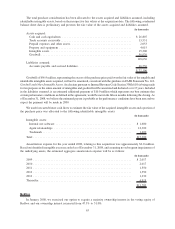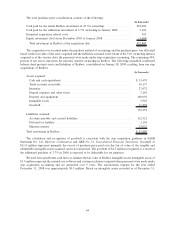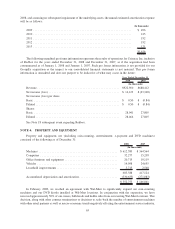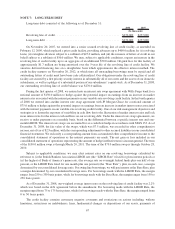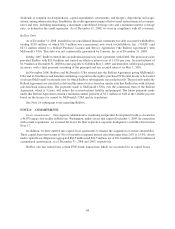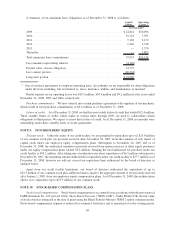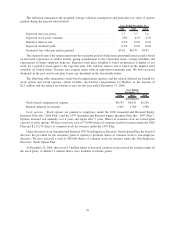Redbox 2008 Annual Report Download - page 62
Download and view the complete annual report
Please find page 62 of the 2008 Redbox annual report below. You can navigate through the pages in the report by either clicking on the pages listed below, or by using the keyword search tool below to find specific information within the annual report.notional amount of $75.0 million to hedge against the potential impact on earnings from an increase in market
interest rates associated with the interest payments on our variable-rate revolving credit facility. One of our risk
management objectives and strategies is to lessen the exposure of variability in cash flow due to the fluctuation of
market interest rates and lock in an interest rate for the interest cash outflows on our revolving debt. Under the
interest rate swap agreements, we receive or make payments on a monthly basis, based on the differential between a
specific interest rate and one-month LIBOR. The interest rate swaps are accounted for as cash flow hedges in
accordance with FASB Statement No. 133, Accounting for Derivative Instruments and Hedging Activities
(“SFAS 133”). As of December 31, 2008, the fair value of the swaps, which was $7.5 million, was recorded in
other comprehensive income, net of tax of $2.9 million, with the corresponding adjustment to other accrued
liabilities in our consolidated financial statements. We reclassify a corresponding amount from accumulated other
comprehensive income to the consolidated statement of operations as the interest payments are made. The net gain
or loss included in our consolidated statement of operations representing the amount of hedge ineffectiveness is
inconsequential. The term of the $150.0 million swap is through March 20, 2011. The term of the $75.0 million
swap is through October 28, 2010.
Stock-based compensation: Effective January 1, 2006, we adopted the fair value recognition provisions of
FASB Statement No. 123 (revised 2004), Share-Based Payment (“SFAS 123R”) using the modified — prospective
transition method. Under this transition method, compensation expense recognized includes the estimated fair value
of stock options granted on and subsequent to January 1, 2006, based on the grant date fair value estimated in
accordance with the provisions of SFAS 123R, and the estimated fair value of the portion vesting in the period for
options granted prior to, but not vested as of January 1, 2006, based on the grant date fair value estimated in
accordance with the original provisions of FASB Statement No. 123, Accounting for Stock-Based Compensation.
Prior to the adoption of SFAS 123R we presented all tax benefits resulting from the exercise of stock options as
operating cash inflows in the consolidated statements of cash flows, in accordance with the provisions of the
Emerging Issues Task Force (“EITF”) Issue No. 00-15, Classification in the Statement of Cash Flows of the Income
Tax Benefit Received by a Company upon Exercise of a Nonqualified Employee Stock Option. SFAS 123R requires
the benefits of tax deductions in excess of the compensation cost recognized for those options to be classified as
financing cash inflows when they are realized rather than operating cash inflows, on a prospective basis. Excess tax
benefits were approximately zero for the year ended 2008. Excess tax benefits generated during the years ended
December 31, 2007 and 2006 were approximately $3.8 million and $1.0 million, respectively.
Income taxes: Deferred income taxes are provided for the temporary differences between the financial
reporting basis and the tax basis of our assets and liabilities and operating loss and tax credit carryforwards. A
valuation allowance is established when necessary to reduce deferred tax assets to the amount expected to be
realized. Deferred tax assets and liabilities and operating loss and tax credit carryforwards are measured using
enacted tax rates expected to apply to taxable income in the years in which those temporary differences and
operating loss and tax credit carryforwards are expected to be recovered or settled.
Effective January 1, 2007, we adopted the provisions of FASB Interpretation No. 48, Accounting for
Uncertainty in Income Taxes (“FIN 48”). FIN 48 is an interpretation of FASB Statement No. 109, Accounting
for Income Taxes (“SFAS 109”) which provides comprehensive guidance on the recognition and measurement of
tax positions in previously filed tax returns or positions expected to be taken in future tax returns. The tax benefit
from an uncertain tax position must meet a “more-likely-than-not” recognition threshold and is measured at the
largest amount of benefit greater than 50% determined by cumulative probability of being realized upon ultimate
settlement with the taxing authority. The interpretation provides guidance on derecognition, classification, interest
and penalties, as well as disclosure requirements in the financial statements of uncertain tax positions.
As of the adoption date and as of December 31, 2008 and 2007, we identified $1.2 million of unrecognized tax
benefits which would affect our effective tax rate if recognized.
In accordance with our accounting policy, we recognize interest and penalties associated with uncertain tax
positions in income tax expense. As of the adoption date and December 31, 2008 and 2007, it was not necessary to
accrue interest and penalties associated with the uncertain tax positions identified because operating losses and tax
credit carryforwards are sufficient to offset all unrecognized tax benefits.
60



